Spin Gapless Semiconductor–Nonmagnetic Semiconductor Transitions in Fe-Doped Ti2CoSi: First-Principle Calculations
Abstract
1. Introduction
2. Structures and Calculation Methods
3. Results and Discussion
Interface Structures
4. Conclusions
Author Contributions
Funding
Conflicts of Interest
References
- Nayak, A.K.; Nicklas, M.; Chadov, S.; Khuntia, P.; Shekhar, C.; Kalache, A.; Baenitz, M.; Skourski, Y.; Guduru, V.K.; Puri, A.; et al. Design of compensated ferrimagnetic Heusler alloys for giant tunable exchange bias. Nat. Mater. 2015, 14, 679–684. [Google Scholar] [CrossRef] [PubMed]
- Graf, T.; Felser, C.; Parkin, S.S.P. Simple rules for the understanding of Heusler compounds. Prog. Solid State Chem. 2011, 39, 1–50. [Google Scholar] [CrossRef]
- Galanakis, I.; Dederichs, P.H.; Papanikolaou, N. Slater-Pauling behavior and origin of the half-metallicity of the full-Heusler alloys. Phys. Rev. B 2002, 66, 174429. [Google Scholar] [CrossRef]
- Skaftouros, S.; Özdoğan, K.; Şaşioğlu, E.; Galanakis, I. Generalized Slater-Pauling rule for the inverse Heusler compounds. Phys. Rev. B 2013, 87, 024420. [Google Scholar] [CrossRef]
- Feng, Y.; Chen, H.; Yuan, H.; Zhou, Y.; Chen, X. The effect of disorder on electronic and magnetic properties of quaternary Heusler alloy CoFeMnSi with LiMgPbSb-type structure. J. Magn. Magn. Mater. 2015, 378, 7–15. [Google Scholar] [CrossRef]
- Özdoğan, K.; Şaşioǧlu, E.; Galanakis, I. Slater-Pauling behavior in LiMgPdSn-type multifunctional quaternary Heusler materials: Half-metallicity, spin-gapless and magnetic semiconductors. J. Appl. Phys. 2013, 113, 193903. [Google Scholar] [CrossRef]
- Jourdan, M.; Minár, J.; Braum, J.; Kronenerg, A.; Chadov, S.; Balke, B.; Gloskovskii, A.; Kolbe, M.; Elmers, H.J.; Schönhense, G.; et al. Direct observation of half-metallicity in the Heusler compound Co2MnSi. Nat. Commun. 2014, 5, 3974. [Google Scholar] [CrossRef] [PubMed]
- Feng, Y.; Xu, X.; Cao, W.; Zhou, T. Investigation of cobalt and silicon co-doping in quaternary Heusler alloy NiFeMnSn. Comput. Mater. Sci. 2018, 147, 251–257. [Google Scholar] [CrossRef]
- Wang, L.; Jin, Y. A spin-gapless semiconductor of inverse Heusler Ti2CrSi alloy: First-principles prediction. J. Magn. Magn. Mater. 2015, 385, 55–59. [Google Scholar] [CrossRef]
- Han, J.; Gao, G. Large tunnel magnetoresistance and temperature-driven spin filtering effect based on the compensated ferrimagnetic spin gapless semiconductor Ti2MnAl. Appl. Phys. Lett. 2018, 113, 102402. [Google Scholar] [CrossRef]
- Gao, G.Y.; Hu, L.; Yao, K.L.; Luo, B.; Liu, N. Large half-metallic gaps in the quaternary Heusler alloys CoFeCrZ (Z = Al, Si, Ga, Ge): A first-principles study. J. Alloy. Compd. 2013, 551, 539–543. [Google Scholar] [CrossRef]
- Felser, C.; Wollmann, L.; Chadov, S.; Fecher, G.H.; Parkin, S.S.P. Basics and prospective of magnetic Heusler compounds. APL Mater. 2015, 3, 041518. [Google Scholar] [CrossRef]
- Feng, Y.; Chen, X.; Zhou, T.; Yuan, H.; Chen, H. Structural stability, half-metallicity and magnetism of the CoFeMnSi/GaAs(0 0 1) interface. Appl. Surf. Sci. 2015, 346, 1–10. [Google Scholar] [CrossRef]
- Knut, R.; Svedlindh, P.; Mryasov, O.; Gunnarsson, K.; Warnicke, P.; Arena, D.A.; Bjorck, M.; Dennison, A.J.C.; Sahoo, A.; Mukherjee, S.; et al. Interface characterization of Co2MnGe/Rh2CuSn Heusler multilayers. Phys. Rev. B 2013, 88, 134407. [Google Scholar] [CrossRef]
- Rani, D.; Suresh, E.K.G.; Yadav, A.K.; Jha, S.N.; Varma, D.M.R.; Alam, A. Structural, electronic, magnetic, and transport properties of the equiatomic quaternary Heusler alloy CoRhMnGe: Theory and experiment. Phys. Rev. B 2017, 96, 184404. [Google Scholar] [CrossRef]
- Yang, F.J.; Wei, C.; Chen, X.Q. Half-metallicity and anisotropic magnetoresistance of epitaxial Co2FeSi Heusler films. Appl. Phys. Lett. 2013, 102, 172403. [Google Scholar] [CrossRef]
- Scheike, T.; Sukegawa, H.; Furubayashi, T.; Wen, Z.; Inomata, K.; Ohkubo, T.; Hono, K.; Mitani, S. Lattice-matched magnetic tunnel junctions using a Heusler alloy Co2FeAl and a cationdisorder spinel Mg-Al-O barrier. Appl. Phys. Lett. 2014, 105, 242407. [Google Scholar] [CrossRef]
- Feng, Y.; Wu, B.; Yuan, H.; Chen, H. Structural, electronic and magnetic properties of Co2MnSi/Ag(100) interface. J. Alloy. Compd. 2015, 623, 29–35. [Google Scholar] [CrossRef]
- Fetzer, R.; Wüstenberg, J.P.; Taira, T.; Uemura, T.; Yamamoto, M.; Aeschlimann, M.; Cinchetti, M. Structural, chemical, and electronic properties of the Co2MnSi(001)/MgO interface. Phys. Rev. B 2013, 87, 184418. [Google Scholar] [CrossRef]
- Yamaguchi, T.; Moriya, R.; Oki, S.; Yamada, S.; Masubuchi, S.; Hamaya, K.; Machida, T. Spin injection into multilayer grapheme from highly spin-polarized Co2FeSi Heusler alloy. Appl. Phys. Express 2016, 9, 063006. [Google Scholar] [CrossRef]
- Feng, Y.; Cui, Z.; Wei, M.; Wu, B. Spin-polarized quantum transport in Fe4N based current-perpendicular-toplane spin valve. Appl. Surf. Sci. 2019, 466, 78–83. [Google Scholar] [CrossRef]
- Lkhagvasuren, E.; Ouardi, S.; Fecher, G.H.; Auffermann, G.; Kreiner, G.; Schnelle, W.; Felser, C. Optimized thermoelectric performance of the n-type half-Heusler material TiNiSn by substitution and addition of Mn. AIP Adv. 2017, 7, 045010. [Google Scholar] [CrossRef]
- Casper, F.; Graf, T.; Chadov, S.; Balke, B.; Felser, C. Half-Heusler compounds: Novel materials for energy and spintronic applications. Semicond. Sci. Technol. 2012, 27, 063001. [Google Scholar] [CrossRef]
- Chen, S.; Ren, Z. Recent progress of half-Heusler for moderate temperature thermoelectric applications. Mater. Today 2013, 16, 387–395. [Google Scholar] [CrossRef]
- Bos, J.W.G.; Downie, R.A. Half-Heusler thermoelectrics: A complex class of materials. J. Phys. Condens. Matter 2014, 26, 433201. [Google Scholar] [CrossRef] [PubMed]
- Wang, X.L. Proposal for a new class of materials: Spin gapless semiconductors. Phys. Rev. Lett. 2008, 100, 156404. [Google Scholar] [CrossRef] [PubMed]
- Ouardi, S.; Fecher, G.H.; Felser, C.; Kübler, J. Realization of Spin Gapless Semiconductors: The Heusler Compound Mn2CoAl. Phys. Rev. Lett. 2013, 110, 100401. [Google Scholar] [CrossRef] [PubMed]
- Galanakis, I.; Özdoğan, K.; Şaolu, E.; Blügel, S. Conditions for spin-gapless semiconducting behavior in Mn2CoAl inverse Heusler compound. J. Appl. Phys. 2014, 115, 093908. [Google Scholar] [CrossRef]
- Jamer, M.E.; Assaf, B.A.; Devakul, T.; Heiman, D. Magnetic and transport properties of Mn2CoAl oriented films. Appl. Phys. Lett. 2013, 103, 2–7. [Google Scholar] [CrossRef]
- Feng, Y.; Bo, W.; Yuan, H.; Kuang, A.; Chen, H. Magnetism and half-metallicity in bulk and (100) surface of Heusler alloy Ti2CoAl with Hg2CuTi-type structure. J. Alloy. Compd. 2013, 557, 202–208. [Google Scholar] [CrossRef]
- Bainsla, L.; Mallick, A.I.; Raja, M.M.; Coelho, A.A.; Nigam, A.K.; Johnson, D.D.; Alam, A.; Suresh, K.G. Origin of spin gapless semiconductor behavior in CoFeCrGa: Theory and Experiment. Phys. Rev. B 2015, 92, 045201. [Google Scholar] [CrossRef]
- Galanakis, I.; Özdoğan, K.; Şaşioğlu, E. Spin-filter and spin-gapless semiconductors: The case of Heusler compounds. AIP Adv. 2016, 6, 055606. [Google Scholar] [CrossRef]
- Gao, G.Y.; Yao, K.L. Antiferromagnetic half-metals, gapless half-metals, and spin gapless semiconductors: The D03-type Heusler alloys. Appl. Phys. Lett. 2013, 103, 232409. [Google Scholar] [CrossRef]
- Xu, G.Z.; Liu, E.K.; Du, Y.; Li, G.J.; Liu, G.D.; Wang, W.H.; Wu, G.H. A new spin gapless semiconductors family: Quaternary Heusler compounds. EPL 2013, 102, 17007. [Google Scholar] [CrossRef]
- Bainsla, L.; Suresh, K.G. Equiatomic quaternary Heusler alloys: A material perspective for spintronic applications. Appl. Phys. Rev. 2016, 3, 031101. [Google Scholar] [CrossRef]
- Perdew, J.P.; Burke, K.; Ernzerhof, M. Generalized gradient approximation made simple. Phys. Rev. Lett. 1996, 77, 3865. [Google Scholar] [CrossRef] [PubMed]
- Blöchl, P.E. Projector augmented-wave method. Phys. Rev. B 1994, 50, 17953. [Google Scholar] [CrossRef]
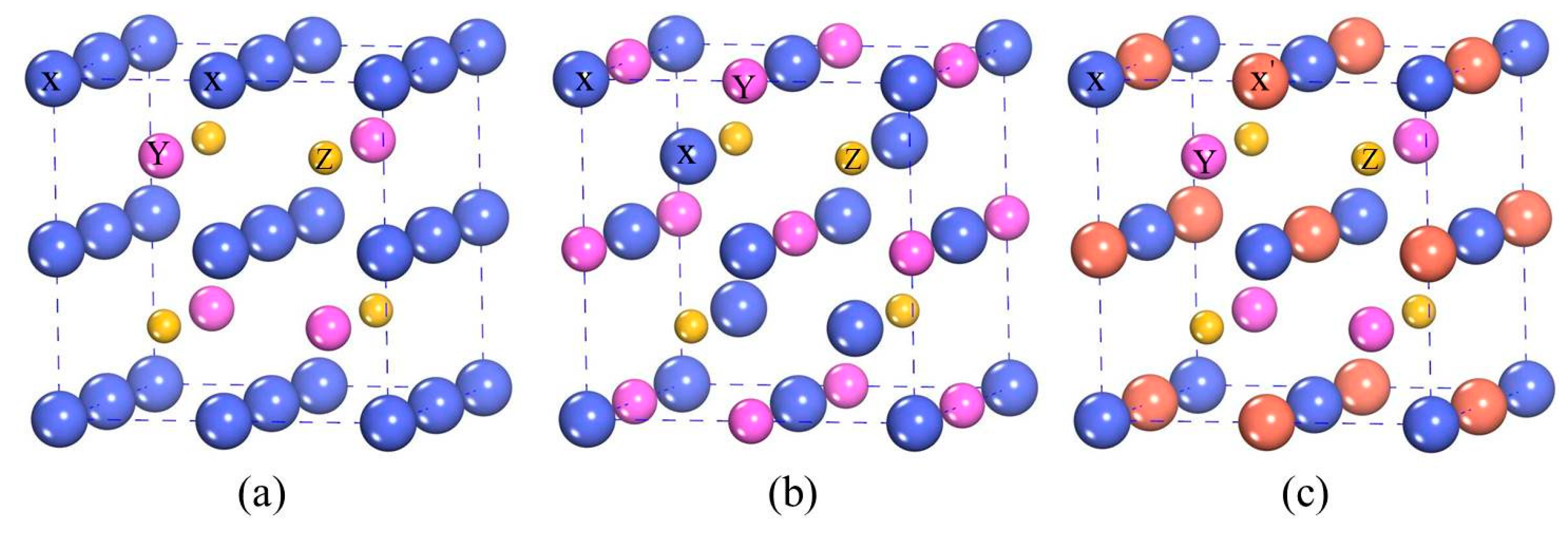
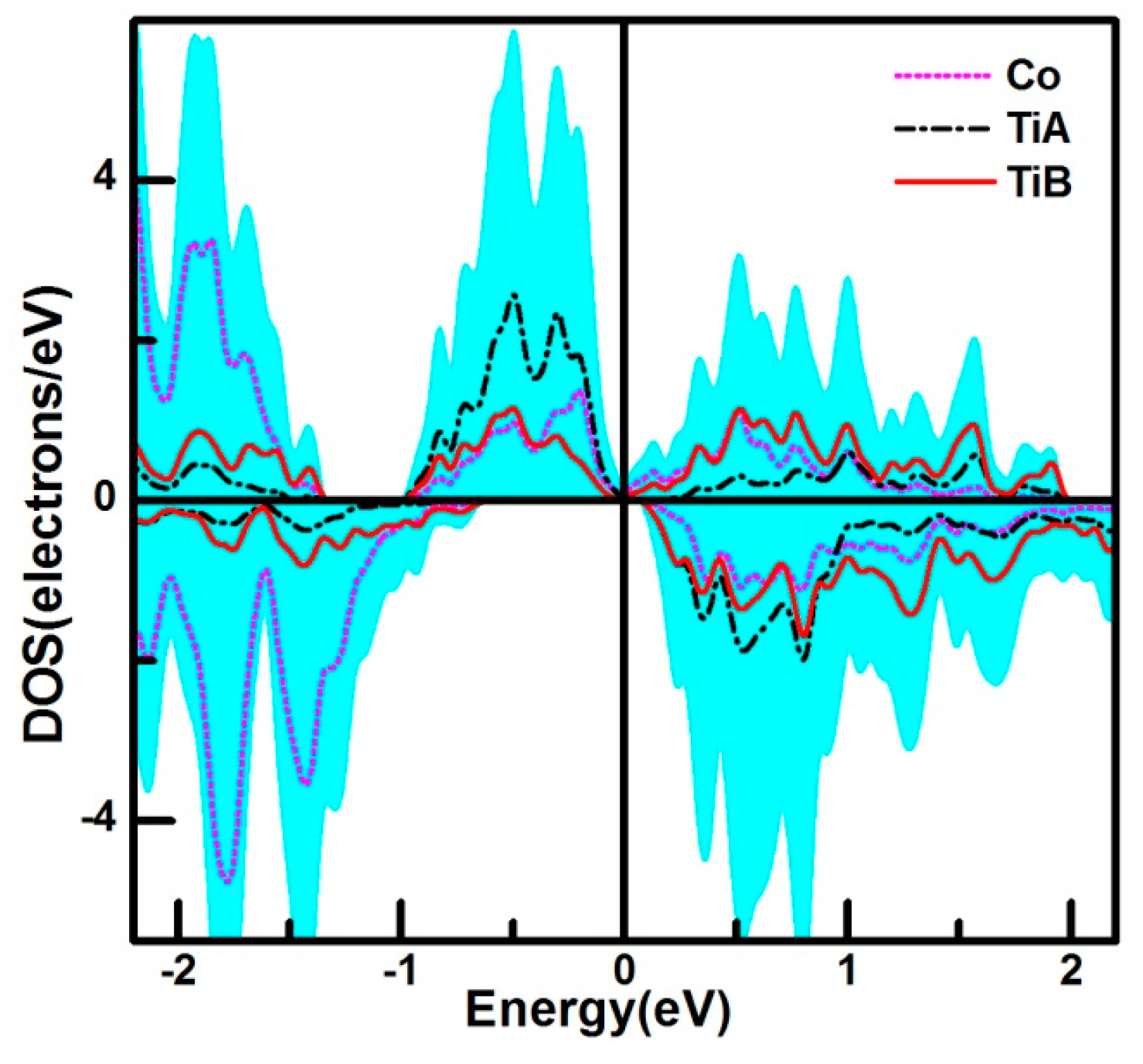

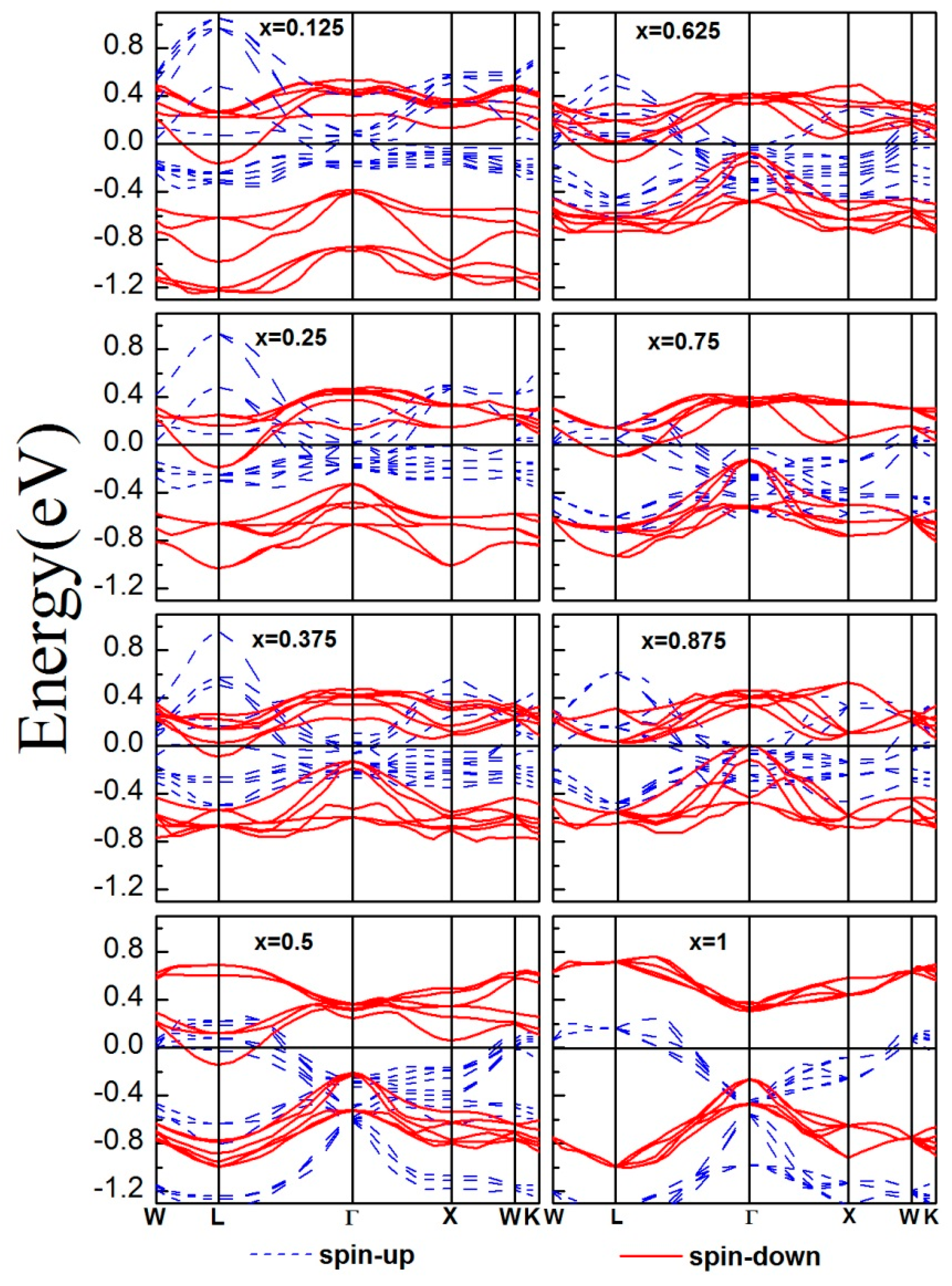
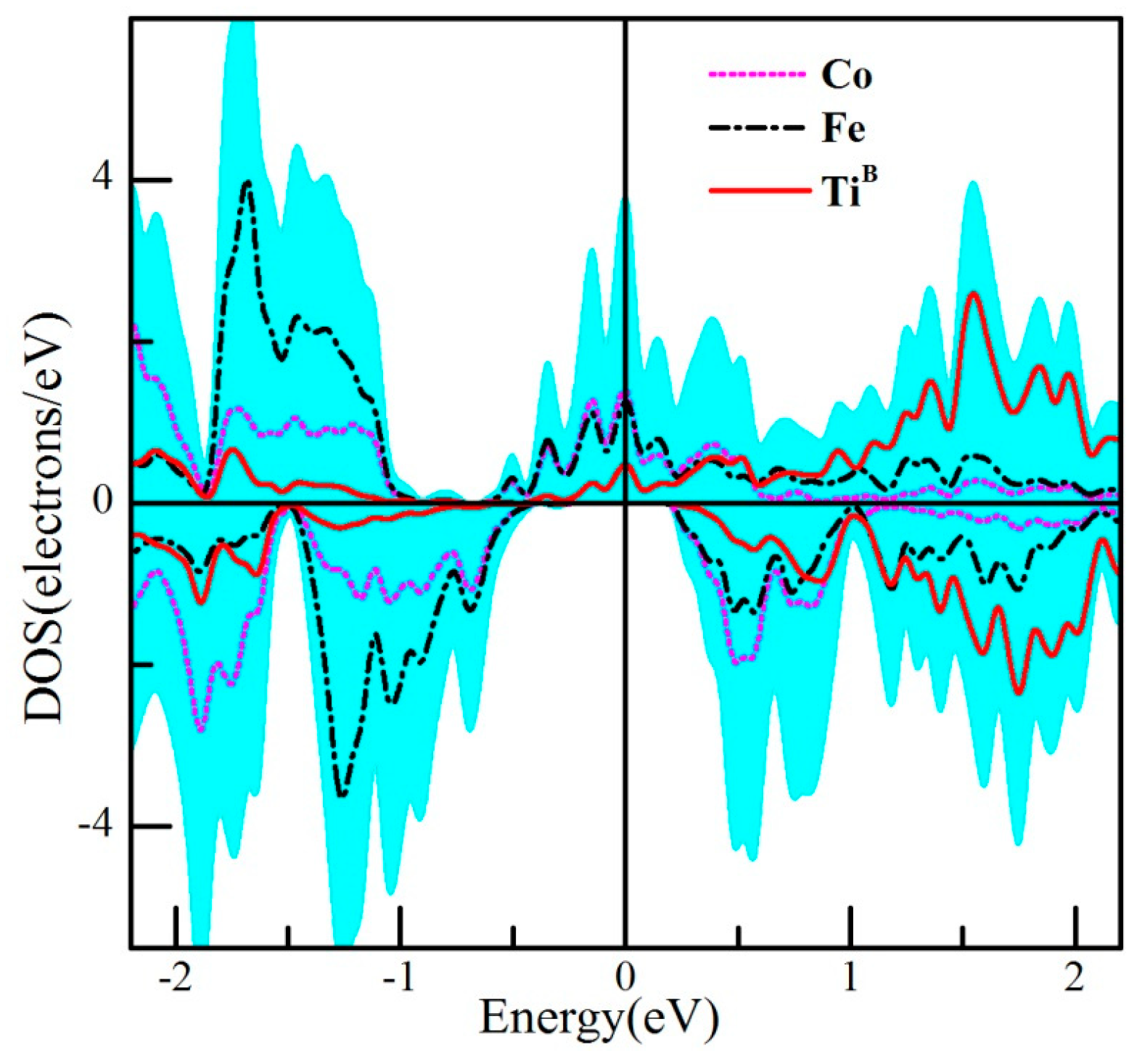
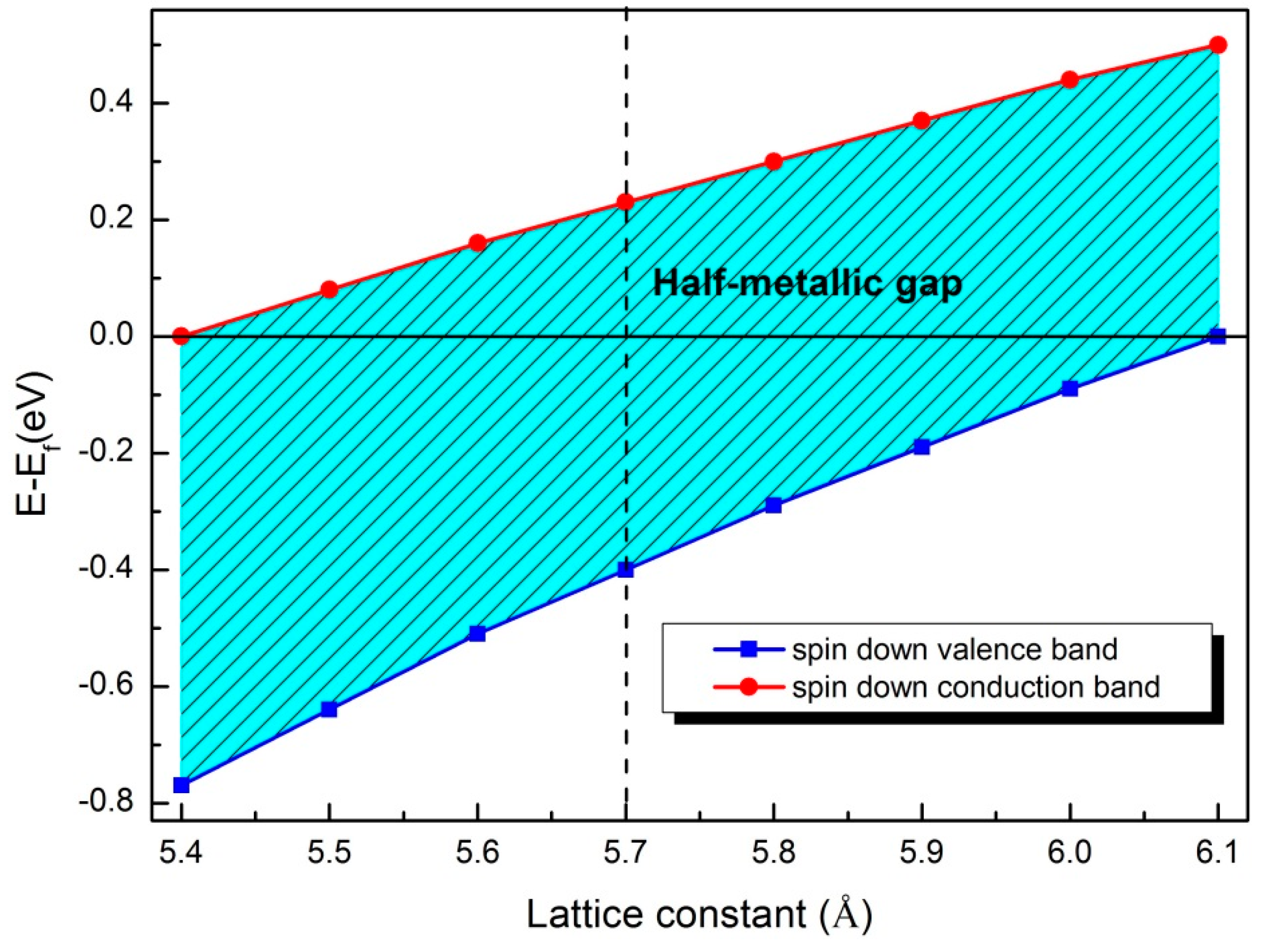

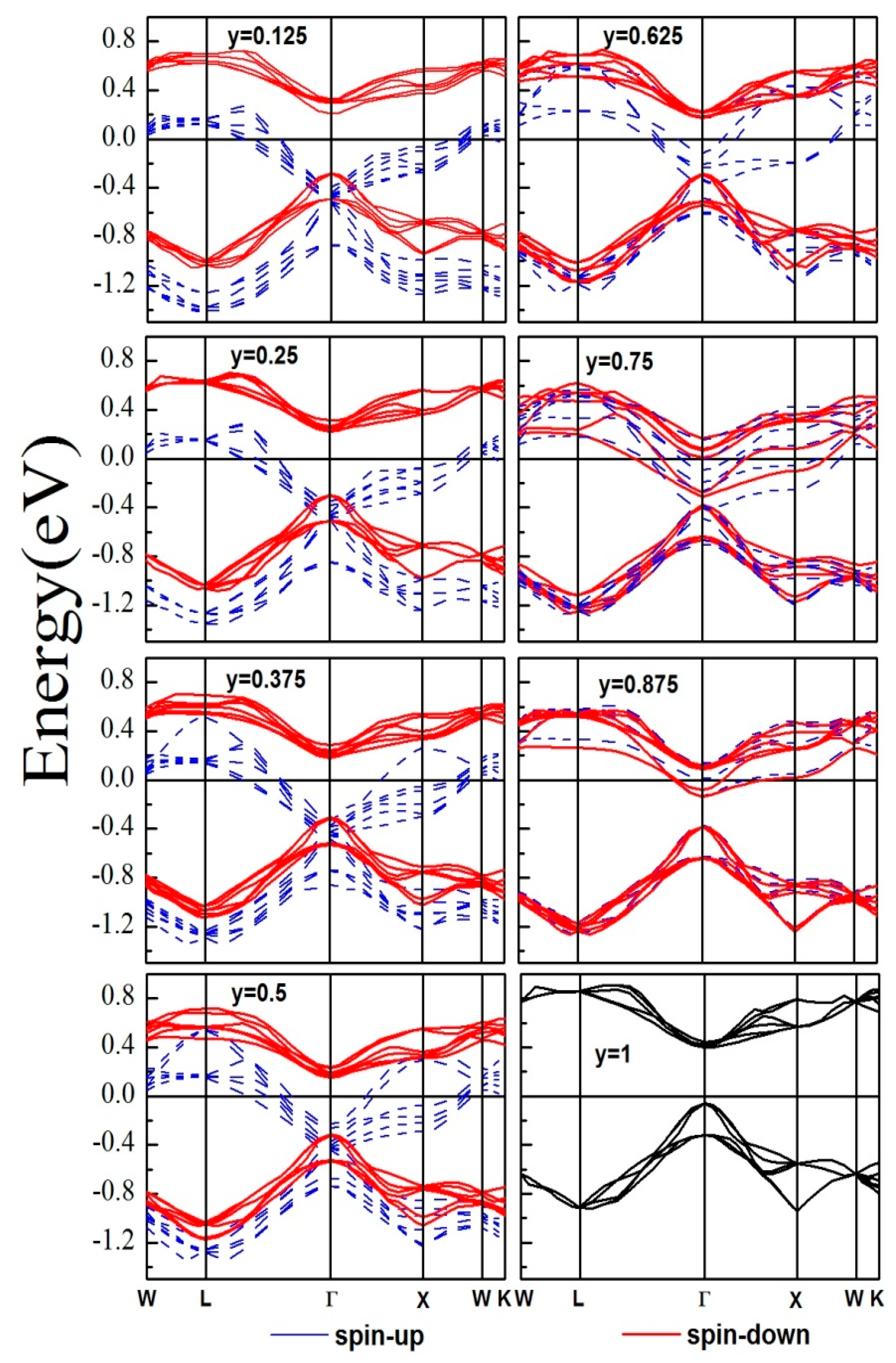

© 2018 by the authors. Licensee MDPI, Basel, Switzerland. This article is an open access article distributed under the terms and conditions of the Creative Commons Attribution (CC BY) license (http://creativecommons.org/licenses/by/4.0/).
Share and Cite
Feng, Y.; Cui, Z.; Wei, M.-s.; Wu, B.; Azam, S. Spin Gapless Semiconductor–Nonmagnetic Semiconductor Transitions in Fe-Doped Ti2CoSi: First-Principle Calculations. Appl. Sci. 2018, 8, 2200. https://doi.org/10.3390/app8112200
Feng Y, Cui Z, Wei M-s, Wu B, Azam S. Spin Gapless Semiconductor–Nonmagnetic Semiconductor Transitions in Fe-Doped Ti2CoSi: First-Principle Calculations. Applied Sciences. 2018; 8(11):2200. https://doi.org/10.3390/app8112200
Chicago/Turabian StyleFeng, Yu, Zhou Cui, Ming-sheng Wei, Bo Wu, and Sikander Azam. 2018. "Spin Gapless Semiconductor–Nonmagnetic Semiconductor Transitions in Fe-Doped Ti2CoSi: First-Principle Calculations" Applied Sciences 8, no. 11: 2200. https://doi.org/10.3390/app8112200
APA StyleFeng, Y., Cui, Z., Wei, M.-s., Wu, B., & Azam, S. (2018). Spin Gapless Semiconductor–Nonmagnetic Semiconductor Transitions in Fe-Doped Ti2CoSi: First-Principle Calculations. Applied Sciences, 8(11), 2200. https://doi.org/10.3390/app8112200




